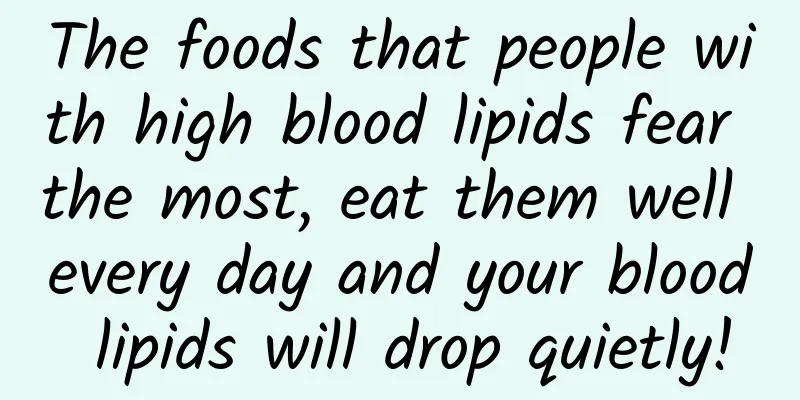The foods that people with high blood lipids fear the most, eat them well every day and your blood lipids will drop quietly!

|
Among the “three highs” (high blood lipids, high blood pressure and diabetes), which one is most likely to be overlooked? High blood lipids! Many people are familiar with high blood sugar and high blood pressure. Diabetes can induce complications such as cardiovascular and cerebrovascular diseases, amputation, blindness, and renal failure. Long-term high blood pressure can also cause cardiovascular and cerebrovascular diseases, kidney disease, etc. In severe cases, it can even lead to cerebral stroke, myocardial infarction, etc. Only high blood lipids (also known as hyperlipidemia) has a relatively high prevalence, but it has not attracted widespread attention. According to the statistical data of the "Guidelines for the Prevention and Treatment of Dyslipidemia in Chinese Adults (2016 Revised Edition)", the overall prevalence of dyslipidemia among adults in my country is as high as 40.40%. That is to say, 4 out of every 10 adults have abnormal blood lipids. What is even more worrying is that the effective control rate of hyperlipidemia is less than half, but many people are unaware of the harm of hyperlipidemia, let alone take it seriously. When blood lipids rise and the blood becomes thicker, the first to suffer are the blood vessels. Blood lipids are more likely to deposit on the blood vessel walls and form small plaques, which is what we often call atherosclerosis. This is like a rusty water pipe. The scale accumulates thicker and thicker, gradually clogging the pipe, and the water flow slows down. Over time, organs throughout the body will suffer from varying degrees of ischemia and hypoxia, causing a variety of diseases. Common ones include coronary heart disease, angina pectoris, myocardial infarction, cerebral infarction, etc., which may endanger life at any time. If there is stenosis in the lower extremity arteries, it will cause indirect claudication, and if there is acute occlusion, limb necrosis may occur; If it occurs in the eyes, it will cause vision loss, or even risk of blindness in severe cases; If it occurs in the ears, it may cause hearing loss. More importantly, high blood lipids, high blood pressure and diabetes are always in cahoots with each other. As long as you suffer from one of them, the incidence of the other two diseases will also increase. The combination of the three will cause damage to the body in an absolute amount of 1+1>2. Taking hypertension + hyperlipidemia as an example, the impact of high blood pressure causes blood vessels to become brittle and hard, blood lipids are more easily deposited, and the speed of development of atherosclerosis increases rapidly, directly increasing the risk of blood vessel blockage and rupture. In addition, high blood lipids can also induce acute pancreatitis and fatty liver. Acute pancreatitis is a critical and severe disease. If not treated in time, it can easily develop into acute hemorrhagic necrotizing pancreatitis, which can cause multiple organ failure and may be life-threatening. High blood lipids are harmful and serious, and generally there are no obvious symptoms. This requires us to pay close attention to changes in our bodies. The following five symptoms can be seen: Yellow warts on face Small yellowish rashes appear on the eyelids, which are the size of rice grains at first and slightly higher than the skin. In severe cases, they cover the entire eyelid. In addition to the eyelids, elbows, thighs, heels, etc. are also common sites. Grayish-white ring around the eye The edge of the black eyeball is surrounded by a grayish-white circle or arc-shaped semicircle about 1-2 mm wide. Over time, the color will continue to deepen and become more and more obvious. Yellow nodules on hands Yellow, orange or brownish-red nodules, plaques or rashes appear on the backs of hands, knuckles, elbows, knees, buttocks and other parts of the body, and sometimes yellow or orange stripes appear on the palms. Dizziness and drowsiness Frequent dizziness, headache, chest tightness, shortness of breath, poor sleep, forgetfulness, numbness and heaviness in hands and feet; The mind is not clear in the early morning, which improves after breakfast. I feel very sleepy in the afternoon, but very clear at night. Calf cramps I often have cramps and tingling in my legs. Even after taking calcium supplements and getting enough rest, there is no improvement. If the above symptoms occur, it is best to go to the hospital to check your blood lipid status and intervene and treat it in time. Eat more grains Eat more whole grains, such as oats, brown rice, pearl barley, millet, whole wheat bread or biscuits, and whole corn. These are healthy whole grains that can lower total cholesterol and "bad" cholesterol (low-density lipoprotein cholesterol). Quit smoking and drinking Smoking can damage the heart and disrupt the balance of blood lipids. Alcohol can promote the body's synthesis of triglycerides and increase the level of "bad" cholesterol. Individualized diet control Hypercholesterolemia: Only the blood cholesterol level is elevated while triglycerides are normal. The dietary intake of cholesterol should be limited, such as eating less animal offal, spinal cord, and egg yolks. Hypertriglyceridemia: Only triglycerides are elevated, while cholesterol is normal. Diet should limit food intake, reduce weight, and reach and maintain a standard weight. Combined hyperlipidemia: If both of the above factors increase, they need to be controlled. Avoid eating sweets and eat more vegetables and fruits. Do moderate exercise after meals It is best to schedule it 40 minutes after a meal. You can do some aerobic exercises such as brisk walking, jogging, swimming, etc., for 40 to 60 minutes, until you sweat slightly. Keep your mouth shut, move your legs, and monitor your blood lipids regularly. If your blood lipids are still not up to standard, you should take medication under the guidance of a doctor. Please follow the doctor's instructions. |
<<: What are the ingredients of iced tea? Is iced tea good to drink?
Recommend
What are the common digestive tract tumors related to?
1. Gastric cancer Gastric cancer is a common dige...
How to avoid allergies during pregnancy Why do you get eczema during pregnancy and what to do
During pregnancy, pregnant women's bodies cha...
Symptoms similar to dysmenorrhea in early pregnancy
It is normal to have many symptoms in the early s...
What to do if the uterus is enlarged
Modern society is constantly progressing and deve...
Pictures of common vulvar diseases in women
Reproductive health is an important part of healt...
Can girls take medicine when they have their period?
There are many aspects that women need to pay att...
How can women lose weight if they have abdominal obesity?
Abdominal obesity in women has become the main si...
What should girls do if they have acne?
Most people will get acne when they reach puberty...
I felt it on the fifth or sixth day of pregnancy.
Because the number of days of pregnancy and physi...
Eighty percent of women will get inflammation in that area after pregnancy
Cervicitis is one of the most common gynecologica...
Rejuvenate: 8 simple ways to relieve burnout!
Everyone has experienced being overly tired from ...
What to do if you have a bad temper during menopause
When female friends have menopausal symptoms, the...
Autoimmune diseases: Why does the immune system attack its own cells?
Some people develop autoimmune diseases, and we n...
9 Foods That Make You Age The Best Way to Fight Aging
As we age, we all want to look younger. But thing...









